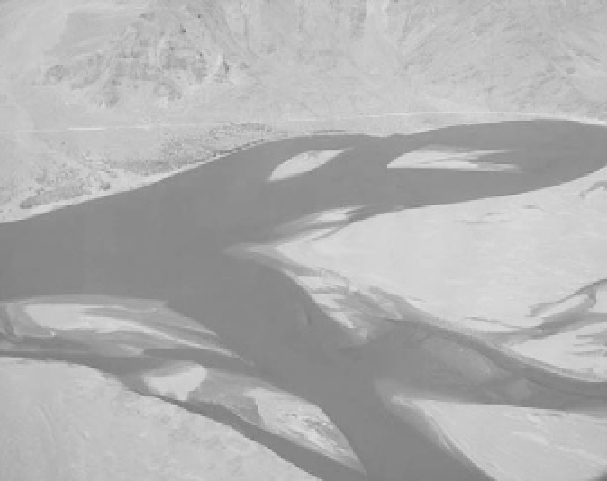Environmental Engineering Reference
In-Depth Information
points of inflection and pools at bend apices. Consequently several models of the transformation from a
straight to a meandering pattern incorporate riffle-pool development as a significant element (Tinkler,
1970; Keller, 1972). The pattern of flow in meandering channels is regarded by Thompson (1986) as a
natural development of that associated with riffle-pool units in straight channels.
5.3.3 Braided and Anabranching Rivers
Braiding develops in the middle and lower Yangtze River. In the 1,120 km reach from Chenglingji to
Jiangyin, there are 41 braided sections with total length 799 km (71% of the total length of the reach). The
braided channels are very stable because they meet the following conditions for braiding development.
The basic conditions for development of braided channels are: abundant bed load, erodible banks,
highly variable discharge, and high stream power (Knighton, 1998). The availability of a large amount of
sediment supplied from upstream or locally is regarded as a necessary condition for braiding. Where the
load contains a wide range of size fractions, local inability to transport the larger sizes may induce the
initial deposition from which the mid-channel bars evolve. Concentrated deposition in the form of bars
diverts the flow against channel banks, and, thus, contributes to the bank erosion needed for the
development of the wide, shallow channel commonly associated with bed load transport.
Figure 5.47 shows the braided Yalutsangbu River in Tibet. The river carries a large amount of gravel
and fine sand from upstream tributaries and deposit in the middle reaches where the gradient is small.
Many small mid-channel bars formed and they are not stable. The stream is bifurcated into two channels
by one bar and bifurcated again by the second and third bars. Thus, a braided river developed with many
unstable bars. If bars in a braided river are vegetated and stabilized, the braided river becomes
anabranching river.
Fig. 5.47
Braided Yalutsangbu River in Tibet (See color figure at the end of this topic)
In many mountain rivers flood carries cobbles and gravel and deposit them on the bed to form
mid-channel bars. The bars create circumstances for silt and sand to deposit around the bars. Over time,
vegetation develops on the bars, which become islands as if they are stabilized. In the meantime the islands
continue to grow headward with more gravel deposit at the upstream end. Gravel deposit at the head end


Search WWH ::

Custom Search